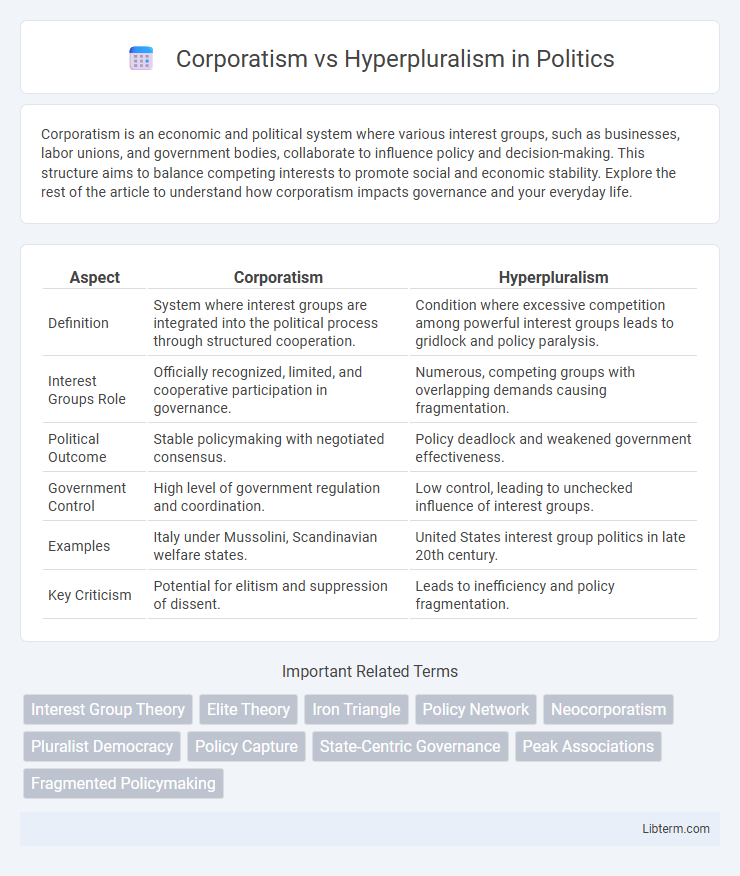Corporatism is an economic and political system where various interest groups, such as businesses, labor unions, and government bodies, collaborate to influence policy and decision-making. This structure aims to balance competing interests to promote social and economic stability. Explore the rest of the article to understand how corporatism impacts governance and your everyday life.
Table of Comparison
| Aspect | Corporatism | Hyperpluralism |
|---|---|---|
| Definition | System where interest groups are integrated into the political process through structured cooperation. | Condition where excessive competition among powerful interest groups leads to gridlock and policy paralysis. |
| Interest Groups Role | Officially recognized, limited, and cooperative participation in governance. | Numerous, competing groups with overlapping demands causing fragmentation. |
| Political Outcome | Stable policymaking with negotiated consensus. | Policy deadlock and weakened government effectiveness. |
| Government Control | High level of government regulation and coordination. | Low control, leading to unchecked influence of interest groups. |
| Examples | Italy under Mussolini, Scandinavian welfare states. | United States interest group politics in late 20th century. |
| Key Criticism | Potential for elitism and suppression of dissent. | Leads to inefficiency and policy fragmentation. |
Understanding Corporatism: Core Principles
Corporatism centers on structured collaboration between the state, businesses, and labor groups to achieve consensus-driven policy solutions, emphasizing organized representation over individual or fragmented interest competition. It relies on formal institutions that integrate interest groups into decision-making processes, fostering stability and coordinated governance. This approach contrasts sharply with hyperpluralism, which highlights the dysfunction caused by excessive and competing interest groups, often leading to policy gridlock.
Hyperpluralism Defined: Key Characteristics
Hyperpluralism is characterized by an excessive number of interest groups that exert influence, leading to fragmented and polarized policymaking. This condition results in government gridlock, as competing factions prevent coherent legislative action and dilute effective governance. The key traits include overlapping interests, intense competition, and a weakened central authority struggling to reconcile diverse demands.
Historical Context: Emergence of Corporatism and Hyperpluralism
Corporatism emerged prominently in the early 20th century as a response to social and economic upheavals, seeking structured collaboration between the state, labor, and business groups to stabilize society and politics. Hyperpluralism arose in the late 20th century within democratic systems characterized by an increased number of organized interest groups, leading to fragmented policymaking and governmental gridlock due to competing and overlapping demands. The historical context of corporatism reflects efforts to harmonize interests through institutionalized representation, while hyperpluralism illustrates the challenges of managing diverse, powerful factions in modern pluralistic democracies.
Structural Differences: Organization and Influence
Corporatism organizes interest groups into structured, often state-sanctioned bodies that collaborate directly with government institutions, creating a hierarchical and integrated system of influence. Hyperpluralism features a fragmented landscape where numerous competing groups operate independently with overlapping demands, resulting in diffusion and potential gridlock of policy influence. Corporatism emphasizes coordinated negotiation within defined channels, whereas hyperpluralism reflects decentralized power struggles among diverse and competing actors.
Role of Interest Groups in Both Systems
In corporatism, interest groups function as organized, officially recognized entities that collaborate closely with the government to influence policy-making through structured negotiation and cooperation. Hyperpluralism describes a system where numerous competing interest groups exert intense pressure on policymakers, often leading to gridlock and fragmented decision-making due to conflicting demands. The role of interest groups in corporatism emphasizes control and integration, while in hyperpluralism, it highlights competition and policy diffusion.
Impact on Policy-Making and Governance
Corporatism centralizes policy-making by involving key interest groups directly in government decision processes, leading to streamlined governance and reduced conflict among stakeholders. Hyperpluralism, characterized by excessive interest group competition, fragments authority and complicates consensus-building, resulting in policy gridlock and inefficiency. Corporatism often produces cohesive policies through negotiated compromises, whereas hyperpluralism can stall governance due to competing, often contradictory demands from numerous groups.
Advantages and Disadvantages of Corporatism
Corporatism streamlines decision-making by integrating interest groups into formal policy discussions, enhancing government stability and fostering consensus-driven outcomes. However, it risks marginalizing minority voices, creating elitist power structures, and reducing competition among interest groups, potentially hindering democratic representation. Its advantages include efficient conflict resolution and policy coherence, while disadvantages encompass limited pluralism and potential for co-optation by dominant groups.
Strengths and Weaknesses of Hyperpluralism
Hyperpluralism highlights the strength of diverse interest groups effectively representing multiple segments of society, ensuring wide-ranging perspectives in policy-making. However, hyperpluralism can lead to governmental gridlock and inefficiency as competing groups create conflicting demands, resulting in policy paralysis. This fragmentation weakens the government's ability to implement coherent policies, often causing delays and watered-down legislation.
Corporatism vs Hyperpluralism: Real-World Examples
Corporatism manifests in countries like Sweden, where government, businesses, and labor unions collaborate to shape economic policies, promoting stability and consensus. Hyperpluralism is evident in the United States, where numerous interest groups fiercely compete, often resulting in policy gridlock and fragmented government responses. The contrasting dynamics of cooperation in corporatism versus competition in hyperpluralism highlight different approaches to managing societal interests and political power.
Future Trends: Navigating Political Representation
Future trends in political representation reveal a shift from hyperpluralism's fragmented interest groups toward corporatism's structured negotiation among key societal sectors, promoting more streamlined policy-making. Technological advancements and digital platforms are expected to reshape corporatist mechanisms, enabling more inclusive yet organized stakeholder participation. Governments may increasingly balance this dynamic to mitigate hyperpluralism's gridlock while preserving pluralistic input in democratic processes.
Corporatism Infographic

 libterm.com
libterm.com